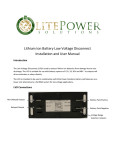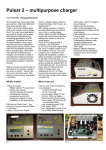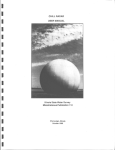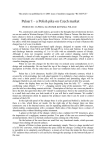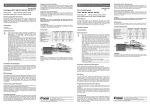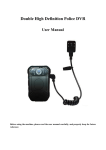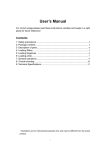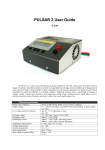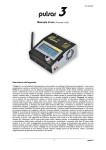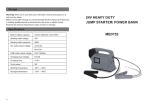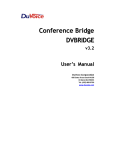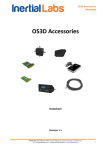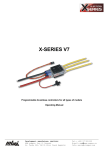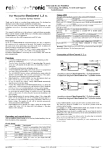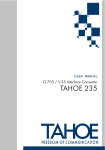Download Someone, surfing the internet (like author does) can take
Transcript
Computerized, fast charger for 1-32 NiCd/NiMH and 1-12 LiPo (max 9.9A) Someone, surfing the internet (like author does) can take advantage of finding news, just after they become available on the net. This way, near the end of previous year I found a new, computerized, fast charger Pulsar 2 with label “Made in Poland”. Technical parameters were very interesting: 1-32 NiCd/NiMH cells, 1-12 LiPo, maximal charging current 9.9A (250W of maximal power), discharging current 9,9A (35W of maximal discharging power without or 250W with return of energy back to the car battery) etc. It’s clear, that this charger got my attention. Immediately, I sent an email to the producer then got quick answer saying, that Pulsar 2 will be available in Germany as well. After few days I received a test version from PPRC Modellbau (Mr. Piotr Piechowski). After opening the of box I saw a quite small device without heatsink. This tiny device has to have 250W of power? Not only. There are more of not less impressive parameters. There’s not enough space to list all of them. Anyway, we’d like to describe most of them here. Pulsar 2 has very rigid, aluminium casing (dimensions: 130x120x60mm) and weight ab. 890g. Casing is made a pulpit-like, what makes using and display reading much easier. 2x16 backlit LCD display is located on the top of casing. Below display, 4 buttons are located and 2 charging sockets on the right. On the left side of casing, there’s sockets of temperature sensor, external cooling fan and RS232. Right side has laser cut cooling holes. Main power cable (for car battery or power supply) is 130cm long, 6mm2 flexible wire with 2, large crocodile-type clamps. MOSFET transistors and double Schottky diode. These components are mounted on the piece of brass (and yet, there’s a radiator, but exactly where it should be – on the power components!) together with quiet, thermo-regulated cooling fan. Great solution! Inside of casing, everything is clean and professionally finished (including very well made main board). There are quite few components (of course, there are some SMD components on the bottom side of PCB): PIC-Flash processor, large coil of voltage converter, and 5V power supply for charger circuit. In the power section we can find 6 Quite brief manual contains 12 pages A5 and is illustrated with diagrams and pictures of display. It’s not easy to write such brief manual to make it understandable for user, especially, when device has a lot of functions. This manual is still developing. This construction is trustworthy. Pulsar 2 is able to reach promised 250W. Additionally a step-up and step-down voltage converter with 65 kHz of work frequency and over 85% of efficiency. So, we can do practical tests with full load. Manual Left side: laser cut cooling holes Upper panel with LCD display Operating After connecting to car battery, charger greet us with short beep and display shows producer’s name and software version. Below are displayed “Start” and “Setup”. I’m sure, it’s a “first sight love”! I was able to use so many chargers without reading of manual, so here I will too. Press “E” button... then press other... then confirm... ooops! Impossible! I can’t do that! There will be no ‘first sight love” and “plug & charge”. So... and yet I’ve to get an operating manual and read every step. Yes. It happens sometimes. In fact, it’s quite easy after you understand manual. My friend told me later: “That’s easy: “M” button choose what have to be done, “E” and “+/-“ changes parameters”. Menu and programs Just after switching on, button “M” enters setup of sound (on/off), Tmax (On/Off), Ton (30 to 45 °C), Toff (50 to 65 °C) and Voff (10 to 11.5V). “E” button start the charger then “+/-“ buttons choose one of eight program memories or one of two special programs (Format/Regeneration or Test). Right side: sockets for temperature sensor, cooling fan and PC Cable Clean construction: there’s cooling fan on the right behind heatsink These 8 program memories can be set up independently, This way you can setup parameters for different types of accus and call them in any moment. It’s really helpful. In Forming and Regeneration (max. 8 cycles) you can’t setup charging and discharging current separately. When given cycle is started, it’s easy to break it up. This will automatically start the next cycle. It’s really praiseworthy. Oh! There’s something else: Thanks to 8 memories, you can use “E” button to display data of these 8 last processes. Pulsar 2 in practice NiCd/NiMH cells you can charge with Reflex mode or without it, using pulsating current with constant value. Reflex mode is identical to ICS1700 processor. The only difference is a discharging impulse. Pulsar 2 has a 1:1 charge to discharge ratio (originally 1 : 2.5). Like in real reflex charging (soft start) Pulsar 2 is charging cells with low current, which reach his set-up value in period of 60 seconds (in 5 steps increases it’s value). Thanks to step-down voltage converter, Pulsar 2 can charge and discharge single cell with maximal current - 9.9A (great for cells selection). Maximal charging current (9.9A) can be used for 1-18 cells. Starting from 19 cells, Pulsar 2 reduces maximal current (physics is omnipresent!). Worth noticing is fact, that Pulsar 2 can charge battery packs in transmitters with protection diode. You can use it to charge battery pack in Multiplex Evo transmitter too. Charging is turned off via delta peak or inflex method. For NiCd/NiMH one of two parameters are available to change: low /high (-7mV/-3mV or -10mV/-5mV). In the inflex method, cells are not overcharged like in delta peak. Charging process is interrupted just before full charge. This makes cells much cooler and belongs their life time. Someone would want hot cells with more pressure – ok, just charge them with higher current (with capacity few % lower). There is one more safety parameter: charging can be interrupted by temperature control. There is a risk of premature charging interrupt. Due to this, producer suggest to use inflex mode for current over 1C and more than 4 cells. In delta peak mode, differences of switching voltage are very low (gentle for cells) therefore for current lower than 1.5C delta peak should be set to “high” and to “low” for higher than 1.5C. Because Pulsar 2 measures battery pack voltage in “nocurrent” impulses, results are lower than during measuring with universal millimeter. Good to know it! Discharging of NiCd/NiMH offers 2 methods: auto or constant current. “Auto” discharges cells to 0.9V per cell first using chosen current then lowering current until it reach 200mA. Of course it takes longer time, but achieved capacity is higher than in constant current mode. “Auto” should be switched off only, when we want to quickly discharge or discharge/charge. In this case, discharging will be interrupted immediately when voltage drop to 0.9V per cell (with current reduced to 200mA). Pulsar 2 „on his own” can discharge up to 35 Watt – what is a good result. Maximal temperature measured at back panel was 42 °C, what was achieved thanks to temperature controlled cooling fan (it’s switched on at ab. 38 °C). Using reverse (return of current to the car battery), is possible to achieve even 250W. Of course even with 9.9A of discharging current. Li-Po, Li-Ion, Li-Ta, RAM and Pb cells are modes interesting for most of users. There are 2 methods of charging for Li-Po/Li-Ion: normal and fast. In “normal” method, cells are charged with constant current. Charging is switched off after reach of 200mAh. With this value discharging time is shorter and energy lower compared to other chargers, which discharges to achieve 100mA or even 30-40mA (for 800 mAh cell it’s a difference of 1.5-2%). Maximal, final charging voltage is 4.20V per cell and can be set up in range 4.0-4.2V in 0.01V steps. Pulsar 2 has a very accurate voltage measuring. It results with very good cooperation of charger with balancers available for the author during writing of this review: Li-Po Checker from Orbit, CSMBalancer from Lipoly.de and KC Balancer from Karsten Camlott. „Fast” mode for Li-Po cells is a „specialty of Pulsar 2”. Is it impossible to use most of today available balancers, because in the final phase, impulse voltage can reach 4.255V per cell. All cells have to be balanced before charging in “fast” mode! I’m sure, that “fast” mode will not be accepted by most of users, because it’s a new feature. It’s clear, that Li-Po cells producers recommend charging with 1C current (with final voltage 4.235V per cell). Noticeably shorter charging LCD display’s charging in 4+1s sequence: C (charge), 10 cells, current, actual voltage (↑=ascending), time and “pumped” capacity (Ah), 1s: input voltage and temperature. Technical data Pulsar 2 front view time can be achieved using higher than 1C current (1.5-2C). Anyway, it’s good to have “fast” mode on hand, what can be chosen by some users. Since long time, many colleagues are charging their packs with higher currents: 1.5C or even 2C. Probably packs charged 1C has longer lifetime or on the other side: Li-Po charged with high current would be quicker charged, but will not reach long lifetime. There is something else: please, don’t underestimate safety level of Li-Po cells. Today’s technology is quickly evolving. Li-Po cells are more safe and could be charged with higher currents, however modelers are more smart what concerns chargers as well as charging technology. Also, more producers allow charging current 1.5C or even 2C. Battery test program is very interesting too. You can measure internal resistance of pack and even single cells however result contains resistance of cables and plugs. Measurement can be done using freely adjustable current (up to 4A) apart from cell type. According to user’s manual, these measurements are for comparing, not absolute. Comparing two packs with exact capacity better is pack with lower resistance. And last, but not least: regeneration program. Even 2 -3 cycles shows, that “bad” packs are not too old yet. Ir’s another “great to have” function. On the end some more nice details: Pulsar 2 works great even, if there are more chargers connected to the same power source. In charge/discharge mode, display backlight is turned off (power saving). It’s turned for short time automatically (to catch user’s attention) only, when some work parameters are changing. Backlight can be turned on any Power supply Car battery min. 30 Ah recommended 70 Ah Mains power supply: 14 V/30A (min. 10A) Power supply voltage: 10 – 16 V Idle current: 140 mA Idle current 60 mA Auto shut-down minimal voltage: min. 10 V do 11,5 V Auto shut-down maximal voltage: > 16V Reversal polarity protection: Input: yes Output: yes Connectors: 6 mm² cable and crocodile type clamps i Charge power: 250 W Charge current: 9,9 A Number of cells: 1 - 32 NiCd/NiMH 1 - 18 Pb 1 - 26 RAM 1 - 12 LiIon/LiPol Discharge power:: 35 W/250 W (with energy return to car battery) Discharge current: max. 9,9 A Final discharge voltage: 0,9 V per NiCd/NiMH cell Voltage converter step up/down: yes/yes Voltage converter frequency: ab. 65 kHz Automatic programs: Process memories: 8 Program memories: 8 Temperature measurement range: 0 – 99 °C in 0.1 °C steps Voltage measurement range: 0,1 - 60 V Current measurement range: 0,1 – 11 A Timer: up to 14 hours External cooling fan max current: max. 1,2 A (with protection) Display: LCD 2 x 16 backlight Information’s Acoustic and visual alerts Update: yes (see text) Dimensions: 130 x 120 x 60 mm Weight (incl. cable): ab. 890 g Price: 269 € (incl. Temperature sensor, PC cable and software) Distribution: PP-RC Modellbau www.pp-rc.de time for period ab. 20s by short pressing of any button. Before charging/discharging you have to confirm number of cells and set their capacity. In fact, capacity parameter is a limiter to set charging energy. This way you can charge fully discharged pack to some lever which is useful for NiMH or Li-Po packs storage. When you set capacity to 3600mAh for 3300mAh pack, charging will be interrupted no later than after pumping of 3600mAh – it’s a safety function. Software Graf PC (V2.27) software was written to record parameters of charge/discharge process’s. It’s very helpful. Every graph can display 4 functions at once: voltage, current, change of voltage per minute and temperature. You can type producer of cell, capacity and brief note in editor window. It’s a standard in MS Windows, that more than one graph windows can be opened at once. „Volt compare” and „Capacity compare” gives you possibility of comparison of data (column graphs). There is an additional window “data” which shows voltage, current, time, change of voltage per minute, temperature and cell capacity. It can be displayed as per one cell too. Unfortunately, there isn’t possible to export graph in different formats like jpg, gif, xls etc. Anyway, this software is very easy to use. It’s in English, but anyone can learn few common words in short period. Magazine: Author: Translate: Produce: elektroModell 4/2005 http://www.modellbauportal.de http://www.neckar-verlag.de Milan Lulić Marek Szulen EN Piotr Piechowski PL http://www.pp-rc.de Elprog S.Krymski http://www.elprog.com.pl Charging/discharging process graph: 7 cells Sanyo RC-4/5 S.C. (1600 mAh) Column graphs: charged/discharged capacity My conclusions Pulsar 2 is very reliable charger which can charge all currently available cell types. Thanks to great technical parameters, professional build and reliable work surely means highest class of charger. With it's 9.9A of charge/discharge current (even for single cell), Pulsar 2 is a "power" charger, which don't have to hide from more expansive, competitive products - it's a charger done with rule: "for professionals by professionals". Many years of experience with Pulsar 1 (older brother of Pulsar 2) resulted in improved construction of Pulsar 2. There is software update possible of PIC processor unit. To update, Pulsar 2 have to be send to the producer (there is a hardware update possible if needed). Full set of Pulsar 2, including PC cable, temperature sensor and software cost is 269€ (as of 8/2005). It’s great functionality to price ratio. At the end: there wasn’t “first sight love”, but great friendship for sure.




